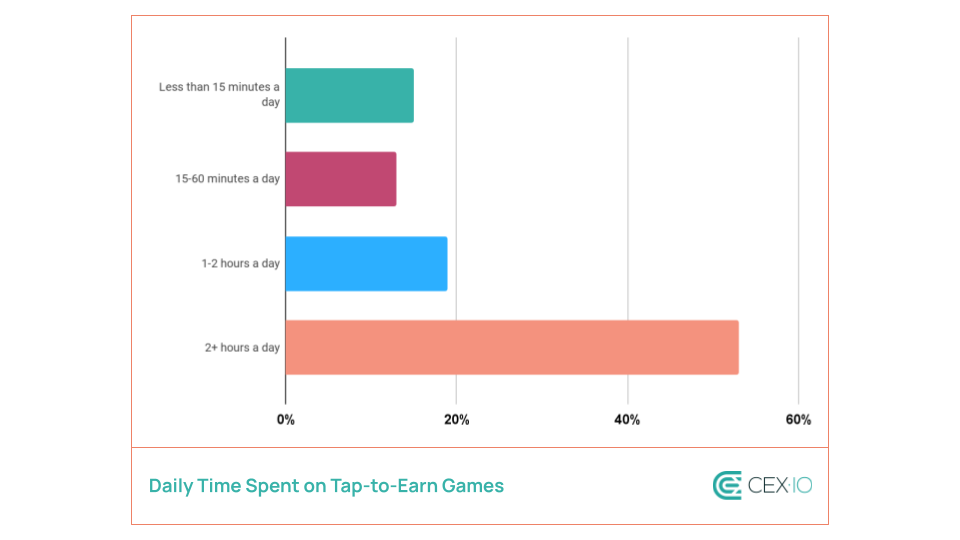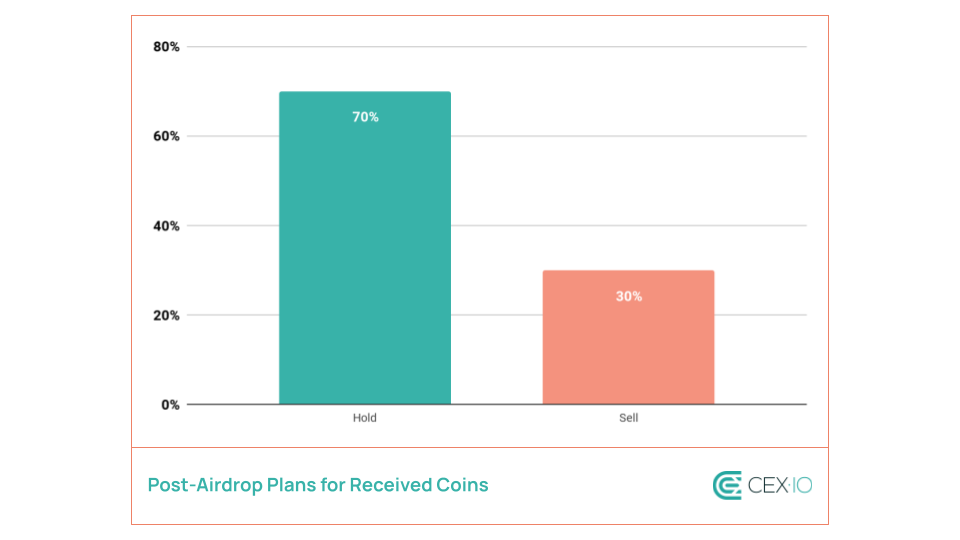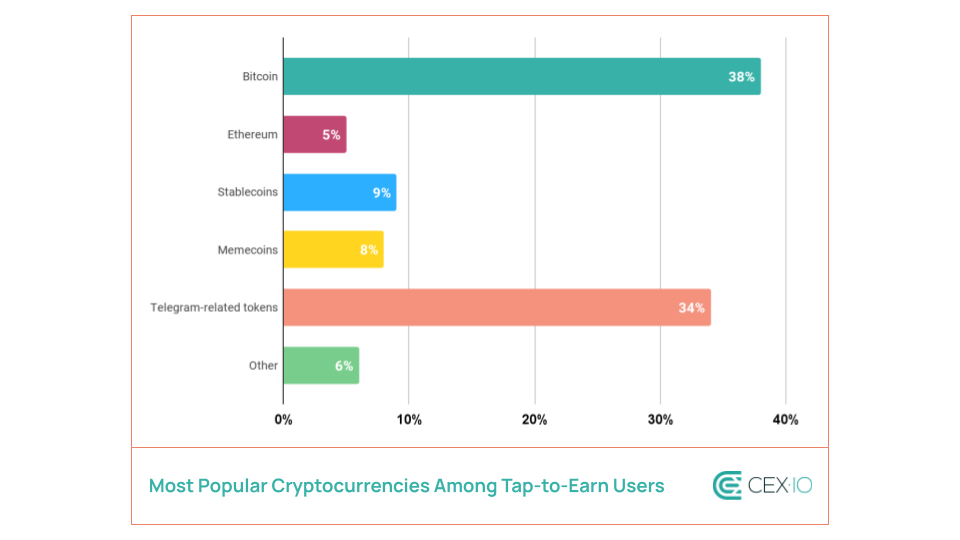Table of contents
- Methodology
- Key figures:
- Introduction
- Part 1: A Road to the Tap-to-Earn Frenzy
- 1.1. Main Trigger
- 1.2. Estimated Core Audience Size
- Part 2. A Portrait of a Tap-to-Earn Game Audience
- 2.1. Engagement: Strong Involvement
- 2.2. Crypto Experience: Typically a Newbie
- 2.3. Crypto Understanding: Mostly Basic
- Part 3: Are Tap-to-Earn Gamers Here to Stay?
- 3.1. Main Intention: HODL coins
- 3.2. Primary interest: Bitcoin and Telegram-related tokens
- 3.3. Existing portfolio: Doubtfully diversified
- Conclusion
Methodology
The data for this study, aimed at constructing a comprehensive profile of tap-to-earn gamers, was gathered through a series of polls conducted within the CEX.IO Official Community Channel on Telegram. This community consists of over six million subscribers, with over 99% of them having engaged with our own tapping game, CEX.IO Power Tap.
A total of 45,537 respondents participated in the survey, with collected responses providing significant insight into the preferences and engagement patterns of tap-to-earn participants. However, since the polls were conducted anonymously on Telegram, we cannot verify the absolute accuracy of individual responses.
To estimate the core audience of tap-to-earn users on Telegram, we extrapolated key findings from the polls and compared them with data from CEX.IO Power Tap. In addition, we incorporated publicly available data from Telegram alongside official reports from over 20 popular tapping games, each with a user base exceeding 10 million and more than 5 million active monthly players.
Key figures:
- 147+ million users are identified as the core tap-to-earn audience.
- 94+ million users with no prior crypto experience have become active tap-to-earn gamers.
- 7+ tapping games are played by the average user.
- 2+ hours per day are spent on tap-to-earn activities by players.
- 40% of players reported that they became involved in crypto within the last six months.
- 29% of tap-to-earn players have never made a single crypto transaction.
- 70% of players stated they intend to hold the coins received from airdrops.
Introduction
Over the last six months, Telegram-based tap-to-earn games has been one of the largest buzzwords in the crypto industry. With some projects beating Guinness World Records in subscriber-based milestones and joining leaders in terms of holder count, these mini-games achieved in weeks what have taken years for some top-tier crypto platforms. They also turned into one of the fastest approaches to building and establishing a community in space.
CEX.IO rapidly identified a new trend to bring masses to crypto, and was among the first global crypto exchanges to join this sector by launching its own tapping game, Power Tap, in May 2024. In less than two days, CEX.IO Power Tap attracted over 1 million players, and is currently enjoying over 30 million users. With CEX.IO Power Tap on board, we received a valuable perspective on the behavior of active tap-to-earn gamers, and decided to share some findings to help the crypto industry better navigate into this phenomenon and understand this audience.
Part 1: A Road to the Tap-to-Earn Frenzy
1.1. Main Triggers
Less than a year ago, in November 2023, a group of developers introduced a beta version of Notcoin with an entirely blank whitepaper, offering users to “mine” coins by tapping their screen. The project initially positioned itself as a memecoin with no clear purpose, reaching over 300,000 users in its first two weeks. However, an actual initial surge happened after Notcoin’s official launch on January 1, 2024, which pushed the number of Notcoin users from 1 million to 15 million in a few weeks. This rapid growth sparked the first wave of similar tap-to-earn projects.
The largest trigger to fuel the hype arguably was Notcoin’s token launch on May 16, 2024, which proved to players that such an activity could have an earning potential. Following this event, Telegram-based tap-to-earn games faced a massive and immediate boost in user activity. For instance, according to the data published by Hamster Kombat, the platform saw an increase from 5 million to 7 million active players in 10 days ahead of the NOT launch. However, after the event and over the same period of time, Hamster Kombat’s active players surged from 10 million to 42 million, continuing exponential growth in the following weeks.
1.2. Estimated Core Audience Size
While Notcoin was instrumental in building the initial core audience of tap-to-earn gamers, the platform is no longer among the top 20 by monthly active users (MAU), with a current player base of 8.7 million. As of this writing, the top 15 Telegram-based tapping games boast a combined MAU of over 422 million, with Hamster Kombat, Blum, Dogs, and Major accounting for half of this total. These largest Telegram-based tapping games include CEX.IO Power Tap, with 16.5 million MAU — it’s more than the combined number of monthly active users on the Bitcoin and Ethereum networks, according to TokenTerminal. The MAU information is drawn from the official Telegram bot data of each participating platform.
However, it’s important to consider that many tap-to-earn games are closely interconnected, often featuring tasks that encourage users to join other similar projects. As a result, players frequently engage with multiple games simultaneously, which may significantly reduce the potential estimates for the actual number of unique active users in the sector.
Based on official Telegram data and reports by the largest tap-to-earn games, supported by player behavior data from CEX.IO Power Tap, the estimated core tap-to-earn audience stands at over 147 million. This includes active players of the 15 most popular tap-to-earn games who typically interact with multiple titles.
Part 2. A Portrait of a Tap-to-Earn Game Audience
2.1. Engagement: Strong Involvement
53% of respondents stated that they spend over two hours a day playing these games. This indicates that for many players, these games are more than just a casual pastime, but a significant daily activity. In addition, the second-largest group spends 1-2 hours per day playing, further highlighting the level of commitment many players have to these games. Only 15% of tap-to-earn games claimed that they might not interact with a tapping game every day, or spend less than 15 minutes playing.

A key catalyst behind allocating over an hour a day for a tap-to-earn activity could be that 76% of respondents are playing at least five games simultaneously. This indicates that tap-to-earn players are typically exploring similar platforms, likely seeking to maximize their earning potential.
2.2. Crypto Experience: Typically a Newbie
64% of respondents highlighted that tap-to-earn games marked their first interaction with digital assets. With an estimated number of core tap-to-earn players of 147 million, this suggests that this gaming model served as an entry point into the broader crypto space for at least 94 million users. Furthermore:
- 40% of respondents stated that they began being involved in crypto activities less than six months ago.
- 29% of players haven’t done any crypto transactions so far.
- 27% of players performed transactions only as a part of the tapping game activity.
In turn, around a third of tap-to-earn gamers had prior experience with cryptocurrencies, with most of them performing regular crypto transactions. This indicates that such an activity also attracts users already versed in crypto, perhaps seeking new ways to engage with and take advantage of industry developments.
2.3. Crypto Understanding: Mostly Basic
As crypto newcomers prevailed in the sample, we wanted to explore if tap-to-earn gamers possess a basic understanding of crypto fundamentals. The dataset included basic questions on Bitcoin, crypto terminology, and the broader state of the crypto industry. 61% of respondents passed the test, while some displayed questionable positions. For instance, 6% of respondents claimed that only 10 digital assets exist, while 5% were assured that Bitcoin was launched by the U.S. central bank.
*Chart Disclaimer: The “Acceptable” category represents the average number of users whose answers were considered relevant based on the overall dataset.
Part 3: Are Tap-to-Earn Gamers Here to Stay?
3.1. Main Intention: HODL coins
Although the main focus for dedicated tap-to-earn gamers arguably remains to maximize the rewards from their efforts, they’re unlikely to seek immediate profit.
Most respondents claimed that they plan to keep the coins they receive after an airdrop, signaling a strong belief in the long-term value of these assets. In addition, half of the respondents who highlighted their desire to keep coins after the airdrop indicated that they would consider staking these assets if there is such an opportunity.

3.2. Primary interest: Bitcoin and Telegram-related tokens
Bitcoin remains the top choice among tap-to-earn gamers, but Telegram-related tokens come close to rivaling the largest cryptocurrency in popularity. The primary driver behind the latter could be the fact that most crypto-tapping activity takes place through Telegram mini apps. Additionally, users’ high engagement with multiple tap-to-earn games and a broader interest in similar projects arguably affected this stance.
In contrast, Ethereum and memecoins showed relatively low appeal among this audience. As a result, tap-to-earn gamers and memecoin enjoyers could potentially be seen as distinct types of crypto enthusiasts, although both activities are perceived to be major drivers of crypto adoption.

3.3. Existing portfolio: Doubtfully diversified
86% of players stated they hold at least one digital asset, with the majority claiming to have a wide array of cryptocurrencies in their portfolio. From one perspective, this suggests that many players are actively exploring and investing in a diverse range of crypto assets. However, considering earlier findings that a significant portion of players engage with multiple games without conducting any crypto transactions, it implies that some participants might view unreleased tap-to-earn tokens as legitimate digital assets.
The latter could be seen as a somewhat dangerous perspective, as players might begin to question the value of certain tap-to-earn projects if they fail to deliver a functional token, leaving it as merely “a part of the game.” This skepticism could extend to doubts about the broader crypto ecosystem as well.
Conclusion
The rise of tap-to-earn models has significantly expanded crypto’s reach by introducing digital assets to users previously unfamiliar with blockchain technology. With over 422 million monthly active users across the largest platforms, these games have become powerful tools for crypto adoption. However, they also bear a responsibility to maintain credibility by delivering sustainable, functional tokens with lasting value.
For many players, tap-to-earn is more than just a game — it’s a meaningful activity that requires time and effort. Furthermore, 70% of users do not plan to sell their tokens after airdrops, signaling their commitment to deeper engagement with the crypto ecosystem.
Positive developments are already emerging, as some tap-to-earn games evolve beyond simple mechanics by integrating gamified onboarding processes and fostering engaged communities. This transformation suggests that these games could serve not only as entertainment but also as gateways to broader crypto participation. For example, CEX.IO Power Tap is exploring educational initiatives to help users better understand blockchain’s potential. The sector as a whole stands to benefit from adopting similar approaches to foster long-term user engagement and sustainable growth.
The web content provided by CEX.IO is for educational purposes only. The information and tools provided neither are, nor should be construed as, an offer, or a solicitation of an offer, or a recommendation, to buy, sell or hold any digital asset or to open a particular account or engage in any specific investment strategy. Digital asset markets are highly volatile and can lead to loss of funds.
The availability of the products, features, and services on the CEX.IO platform is subject to jurisdictional limitations. To understand what products and services are available in your region, please see our list of supported countries and territories. This page includes additional links to information about individual products, and their accessibility.
